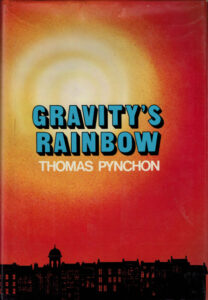by Tore Rye Andersen
The Pynchon Wiki features a great little article by Linda Getter on her husband Marc Getter, the artist behind the striking dust-jacket of the first edition of Gravity’s Rainbow. According to Linda, Marc “loved the idea of a single image being responsible for communicating the essence of a book.” This is a lot to ask of a cover illustration, especially when the book it adorns is as complex as Gravity’s Rainbow, where rockets, dodoes, and pigs intermingle, and where excruciatingly beautiful landscape descriptions and vulgar sex scenes appear side by side with cartoonish tales of the future and pointed political satire. Even though it can be discussed whether Getter’s image communicates the essence of Pynchon’s masterpiece, the cover is certainly iconic. The vibrant colors (which are notoriously prone to fading) make the jacket pop, and the three-dimensional blue letters of the title and the sharp black silhouette of the London townhouses form an arresting contrast to the soft, airbrushed orange and yellow sky.[1]On the 1975 first edition of the French translation of the novel (incongruously titled Rainbow), the anonymous row of townhouses has been replaced with a more recognizable skyline that includes St. … Continue readingI recently published the monograph Planetary Pynchon: History, Modernity, and the Anthropocene (Cambridge University Press, 2023). The book is in many ways a life’s work, a summation of thirty years of deep fascination with and research on Pynchon’s work. As part of this fascination, I have written quite a few articles throughout the years on the paratexts of Pynchon’s novels, including analyses of the covers of V., The Crying of Lot 49, Gravity’s Rainbow, and Inherent Vice. While the paratextual dimension is not central to my new book, my interest in book design made the task of choosing just the right cover image for my book a daunting one.
Briefly told, my book argues that Pynchon’s three largest novels — Gravity’s Rainbow, Mason & Dixon, and Against the Day — can profitably be read as a trilogy, or one large megatext, which presents a coherent world-historical account of how the emergence and global spread of European modernity and resultant phenomena such as industrialization, capitalism, and colonialism have threatened and often eradicated alternative worldviews, peoples, and other lifeforms, all with disastrous consequences for the planet. In other words, Pynchon’s global novels show how the rise of modernity led to the current age of the Anthropocene.
[Read more…]
Footnotes
| ↑1 | On the 1975 first edition of the French translation of the novel (incongruously titled Rainbow), the anonymous row of townhouses has been replaced with a more recognizable skyline that includes St. Paul’s Cathedral and Tower Bridge. |
|---|
